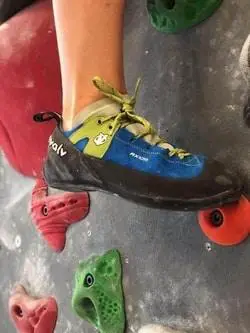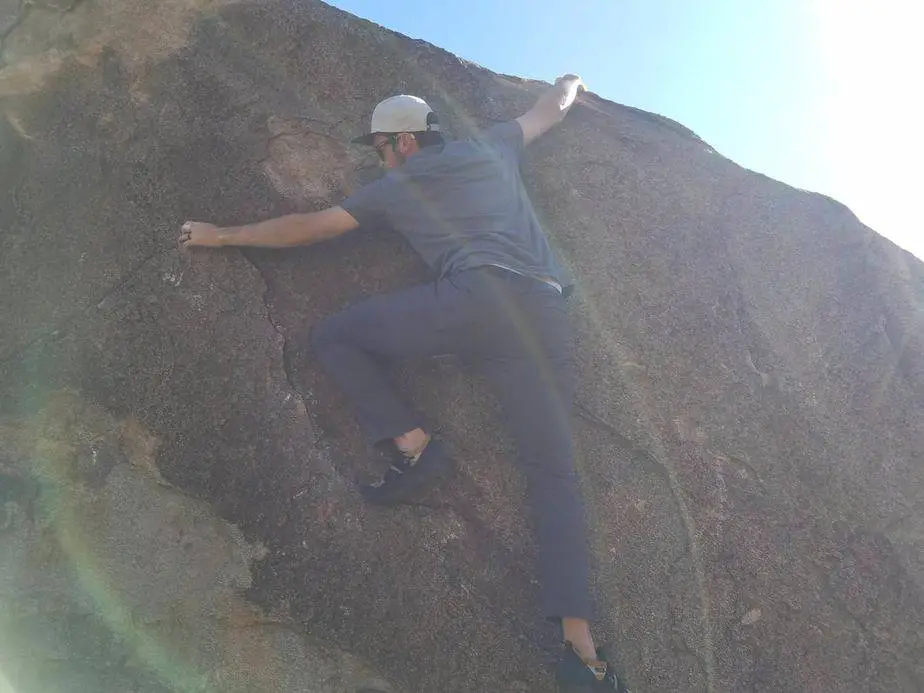The first time you put on a pair of climbing or bouldering shoes, the tight discomfort can really bother you. Shoes have absolutely no padding, and often make your toes curl up in the ends. This discomfort can lead some people to wonder if they need to size up.
You should not buy climbing or bouldering shoes a size bigger, because climbing shoes are meant to fit tightly. Buy climbing shoes that are the same size as your street shoe, or a half size smaller. It’s best to try them on before buying to ensure the right fit.
Climbing shoes need to fit as tightly as possible without hurting your feet, because this gives climbers the best performance. Contrary to old-school belief though, your shoes don’t need to make you lose feeling in your feet. I’ll explain how to fit shoes correctly, while going as small as possible for performance.
What Size of Climbing Shoes to Buy?
Climbing shoes have the terrible reputation of being wildly uncomfortable. In the past, climbers used to buy climbing shoes a few sizes smaller and then cram their feet inside in the hope that the pain would help them get their weight onto a smaller hold.
It wasn’t uncommon to see climbers get to the top of a route, clip in or set an anchor, and peel their shoes off their feet before descending or belaying the follower up. It was a badge of courage to see how many sizes below your street size you could get your feet into, almost reminiscent of the girls binding their feet during the Tang Dynasty in China!
in China!
Additionally, climbing shoe uppers used to be made primarily of unlined leather. Leather stretches out a few sizes as it gets worked, so climbers had to go down several sizes initially with the expectation that they would stretch out over time.
Thankfully, climbing shoe companies have continued to innovate, and have found ways to mostly capture the performance of punishingly tight shoes with different shoe shapes and styles. Even though shoes don’t need to be crazy tight, that doesn’t mean you should size up.

Why You Shouldn’t Size up Climbing Shoes
Climbing shoes are unique in a few ways. They utilize extremely sticky rubber, they mold around your foot, they have a rubber heel and toe cap, and they have a rigid sole at least halfway back on the shoe. This rigid sole is why you shouldn’t wear shoes that are too big.
I would argue that the rigid sole is the most important feature in climbing shoes, right up there with the sticky rubber. We’ve all tried climbing in tennis shoes or even hiking boots, and it’s really hard.
When you put your toe on a small hold, the shoe bends with your toes inside and you slip off. If you have really tight shoes this can help a little bit, but for the most part your toes bend upwards and you slide off the hold.
Climbing shoes, with their rigid soles, make it much more difficult for your toes to bend upwards. The sole effectively extends the toehold out towards the ball of your foot, which is much stronger than your toes. The rigid sole won’t hold all of your weight by itself though; it requires the extra strength of your toes to keep it stable.
If you wear climbing shoes that are too big, then any hold smaller than the space between your toes and the end of the shoe will make your toes bend upwards and send you falling off the rock. Your feet need to go all the way to the end of the shoe in order for them to work properly.
Additionally, bigger climbing shoes mean that there’s a good chance that your feet will slide around a bit while you’re climbing. If you feet slide around, your shoes will create hot spots that can lead to blisters. If you get blisters, that means you can’t climb- and that’s bad.
Different shoes fit different feet differently (I think that makes sense). Shoes are designed with different foot shapes in mind, so it’s important to try them on until you find some that you like.
Some brands run narrow (looking at you La Sportiva), while others have a wider fit. It can be tempting to size up in narrow shoes if you have wide feet, but don’t fall for it.

What is the Advantage of Smaller Climbing Shoes?
The advantage to smaller climbing shoes is in your toes. Smaller shoes make your toes curl up in the end. With your toes curled up, you’re able to stand and balance on the strength of the ball of your foot instead of the strength of your toes.
Smaller climbing shoes sort of work as if you didn’t have toes (obviously that’s not ideal). Your feet are really strong, but the toes are the weakest link.
Smaller shoes help double your toes over, which doubles their strength. This way you can hold up your whole weight on just the tips of your toes.
Even with the development of synthetic material and better leather linings, climbing shoes still stretch out with use. They stretch out a little bit permanently, and stretch a little bit during each climbing session. A shoe that fits comfortably at the beginning of the day can be too large by the end.
When are Climbing Shoes too Small?
Climbing shoes are too small when they adversely affect your climbing because they hurt your feet. If you can’t focus on climbing because your shoes are so tight, you need to reconsider if it’s worth it. They do need to be tight, but they shouldn’t cause pain.
If I’m doing single pitch climbing and trying to climb my hardest and push my grade, I usually wear shoes that are a full size down from my street shoe.
These shoes go on pretty well, but aren’t super comfortable to stand in. They help me climb hard, but I’m always relieved to take them off when I get back to the ground.
If I’m climbing multipitch or bouldering, I usually wear shoes that are a half size down from my street shoe. This is because I’ll be in the shoes for a longer time and don’t want to risk losing a toe!
To reiterate, your shoes should be as tight as you can go without being in pain. If you climb competitively (even with yourself) then you will want a really tight-though not painful- pair to send in. If you climb more casually and just for fun, go for a pair that is comfortable enough to wear for longer periods of time.
How Do I Know What Size Climbing Shoe to Buy?
Here are some tips for selecting the correct size of climbing shoes:
Consider their Use- You will want different sizes of shoes for different types of climbing. If you want performance, an overly aggressive shoe that is as tight as possible will be best. If you want a comfy shoe you can wear all day, a flatter shoe that’s a little roomier will be best.
Find the Right Shape– Every brand fits slightly differently, and every brand makes different “lasts” of shoes. The best way to pick shoes is to try on a bunch of different pairs and see what feels best. Select shoes that are tight on every part of your foot, without leaving any empty space.
Start at Street Size- As a general rule, start with your street size and work down. Simulate climbing footholds and stretching, rather than just standing on flat ground.
Don’t Forget the Stretch- When you’ve selected a pair, think about how much they’ll stretch. It might be worth a really tight session or two in order to make sure they stay tight after they’ve stretched. You can stretch out climbing shoes by wearing them in a hot shower or wearing them around the house.

Related Questions
Are Climbing Shoes True to Size? Most climbers buy shoes a half size smaller than their street shoe with the expectation that they will stretch out over time. Leather shoes stretch more than synthetic material. Each brand and each product line fit a little bit differently, so it’s best to try them on before buying them.
How Tight Should New Climbing Shoes Be? New climbing shoes should be as tight as possible without being painful. You should be able to wear them up a couple of routes without needing to take them off, but they should be uncomfortable because they will stretch out as much as a full size over time.
How Can I Make My Climbing Shoes Bigger? Wear tight climbing shoes in a hot shower to get them to stretch out a little bit. You can also wear them around the house, or watching TV. The longer they’re worn, the more permanent the stretch will be. Leather shoes stretch more than synthetic shoes.

